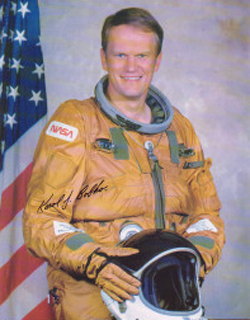- Karol J. Bobko
Infobox Astronaut
name =Karol Joseph "Bo" Bobko
type =USAF/NASA Astronaut
status =Retired
nationality =American
date_birth =birth date and age|1937|12|23
place_birth =New York City ,New York
occupation =Pilot
rank =Colonel , USAF
selection =1966 USAF MOL Group, 1969 NASA Group 7
time =16d 02h 03m
mission =STS-6 ,STS-51-D ,STS-51-J
insignia =Karol Joseph "Bo" Bobko is a retired
United States Air Force officer and a former USAF andNASA astronaut .Personal
Bobko was born in
New York City ,New York to aPolish-American family onDecember 23 ,1937 . He graduated fromBrooklyn Technical High School , New York, then received aBachelor of Science degree from theUnited States Air Force Academy in 1959 and aMaster of Science degree inAerospace Engineering from theUniversity of Southern California in 1970.USAF career
Bobko was a member of the first graduating class of the Air Force Academy. Subsequent to receiving his commission and navigator rating, he attended pilot training at
Bartow Air Base ,Florida , andVance Air Force Base ,Oklahoma . He completed his flight training and received his wings in 1960.From 1961 to 1965, he flew F-100 and F-105
aircraft while assigned as a pilot with the 523d Tactical Fighter Squadron atCannon Air Force Base ,New Mexico , and the 336th Tactical Fighter Squadron atSeymour Johnson Air Force Base ,North Carolina . He attended theAerospace Research Pilot School atEdwards Air Force Base ,California , and was assigned as an astronaut to the USAFManned Orbiting Laboratory (MOL) program in 1966.He has logged over 6,600 hours flight time in the F-100, F-104, F-105, T-33, T-38, and other aircraft.
NASA Experience
Bobko became a NASA astronaut in September 1969 after the cancellation of the MOL program. He was a crewmember on the highly successful
Skylab Medical Experiments Altitude Test (SMEAT) -- a 56-day ground simulation of theSkylab mission, enabling crewmen to collect medical experiments baseline data and evaluate equipment, operations and procedures.Bobko was a member of the astronaut support crew for the
Apollo -Soyuz Test Project (ASTP). This historic first internationalmanned space flight was completed in July 1975. Subsequently, he was a member of the support crew for theSpace Shuttle Approach and Landing Tests conducted at Edwards AFB. He served alternately as CAPCOM and primechase pilot during these Approach and Landing Test (ALT) flights.In preparation for the first flight of "Columbia" (
STS-1 ) Bobko served as the lead astronaut in the test and checkout group atKennedy Space Center .A veteran of three space flights, Bobko logged a total of 386 hours in space. He was the pilot on
STS-6 (April 4-9, 1983); and was the mission commander onSTS-51-D (April 12-19, 1985) andSTS-51-J (October 3-7, 1985).paceflight Experience
Bobko was pilot for STS-6, which launched from Kennedy Space Center in Florida, on
April 4 ,1983 . During this maiden voyage of the spacecraft Challenger, the crew deployed a large communicationssatellite (TDRS) and therocket stage (IUS) required to boost it togeosynchronous orbit . The STS-6 crew also conducted the first shuttlespacewalk (EVA) and additionally conducted numerous other experiments in materials processing and the recording oflightning activities from space. There were also three Getaway Specials activated on the flight. After 120 hours of orbital operations STS-6 landed on theconcrete runway at Edwards AFB in California, onApril 9 ,1983 .On his second mission, Bobko was the commander of
STS-51-D which launched from Kennedy Space Center onApril 12 ,1985 . The mission was to deploy two communications satellites, performelectrophoresis andechocardiograph operations in space, in addition to accomplishing other experiments. When one of the communications satellites malfunctioned, a daring attempt was made to activate the satellite which required an additional EVA, rendezvous, and operations with the remote manipulator arm. After 168 hours of orbital operations Discovery landed on Runway 33 at Kennedy Space Center onApril 19 ,1985 .Bobko's final flight was as commander of
STS-51-J , the second Space Shuttle Department of Defense mission, which launched from Kennedy Space Center onOctober 3 ,1985 . This was the maiden voyage of the Atlantis. After 98 hours of orbital operations, Atlantis landed on Edwards Air Force Base Lakebed Runway 23 onOctober 7 ,1985 .Post-NASA career
In 1988, Bobko retired from NASA and the Air Force to join the firm of
Booz Allen Hamilton , inHouston, Texas . At Booz Allen he was a principal and managed efforts dealing withhuman space flight. His areas of emphasis were: high performance training simulation,hardware andsoftware systemsengineering , spacecraft checkout and testing,space station development and program integration.In 2000, Bobko joined
SPACEHAB , Inc in Houston, Texas where he wasVice President for Strategic Programs. He led an organization which develops concepts, processes and hardware for future spaceflight applications.In 2005, Bobko joined
Science Applications International Corporation (SAIC) as Program Manager for the NASA Ames Research Center Simulation Laboratories (SimLabs) contract. The organization that he leads is responsible for developing and integrating hardware and software for a wide variety simulations, including control system and inceptor design, air traffic management concept research, human factors research, and cockpit display evaluations. SAIC staff are also responsible for operational support of simulations, including the large amplitude Vertical Motion Simulator and several high fidelityflight simulators .Awards and honors
*
NASA Space Flight Medal s (3)
*NASA Exceptional Service Medal s (2)
*JSC Group Achievement Awards (6)
*Defense Superior Service Medal
*Legion of Merit
*Defense Meritorious Service Medal
*Distinguished Flying Cross
*Meritorious Service Medals (2; 1970 and 1979)
*Air Force AcademyJabara Award (1983)ee also
*
Booz Allen Hamilton External links
* [http://www.jsc.nasa.gov/Bios/htmlbios/bobko-kj.html Source]
* [http://www.spacefacts.de/bios/astronauts/english/bobko_karol.htm Spacefacts biography of Karol J. Bobko]
Wikimedia Foundation. 2010.
